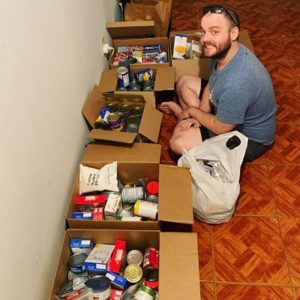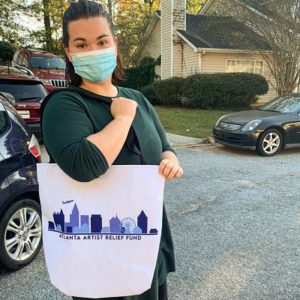This story is part of a package on the one-year anniversary of the COVID-19 lockdown.
At the onset of the pandemic last year, one response of theatre companies and arts organizations across the country was to set up relief funds in an effort to mitigate the looming effects of an economic crisis. As artists and arts administrators know well, widespread financial setbacks tend to hit the arts and its workers harder than others, as the precarity of the nonprofit arts system is so easily exposed and exploited. Now, one year after almost all U.S. theatres shut down in-person operations, suspending shows and adjusting to digital productions on a moment’s notice, many artists are still relying on the helping hand of these relief organizations for emergency grants, food and resource donations, and communal support. With no clear model of industry-wide reopening, makeshift funds and aid groups are preparing to make this work until at least the end of 2021.

Many funds have maintained a somewhat steady cash flow in the year since the shutdown, with large donations coming from institutions like the Tides Foundation or the Mellon Foundation. Others have subsisted on donations raised by communities themselves, with artists redistributing funds in a pay-it-forward model once they’re back on their feet. Though it can be heartening to hear about a community or group of artists that has rallied together to survive a year of unexpected economic challenges—from jobs lost months in advance to artists’ unions cutting health insurance to the constantly fluctuating state of our stimulus checks—it’s also a reminder that the safety net some feel was ripped out from under them at the onset of the pandemic was never really in place for many others.
“Access to a career in the arts is fundamentally inequitable,” said Bridget McCarthy (she/her), the executive director of Atlanta Artist Relief Fund (AARF). An actor and teaching artist, McCarthy first joined AARF in April 2020 when her last “day hustle job” went under. “Risk tolerance belongs to a certain subset of people, and that intersects with every single aspect of privilege.” To counterbalance this systemic effect, the AARF team works to make resources like meals, prescription deliveries, and childcare accessible to artists in every Atlanta-area zip code. They rely on the premise (and promise) of mutual aid, but don’t exclude those in need who may not have anything to offer in return at any given moment.
“I think it would be cool if COVID was the start of all of our problems, and the end of COVID [were] the end of our problems,” McCarthy said. “But realistically, we know that inequity has existed in the arts world for a long time.”
To address longstanding issues, AARF intends on evolving in a post-pandemic world and adapting their mission to the community’s needs. They hope to raise enough funds to establish a physical branch where they can house a community food pantry, offer access to in-house, in-person mental health professionals, and open a gym. “Eventually, we hope to be able to help with subsidized housing as well,” Robby Owenby (he/him), AARF’s director of marketing and engagement, said. The group’s main concern a year into the pandemic is not so much when physical theatre spaces will reopen, but who will be left to sustain them.
TheatreWashington’s relief efforts will similarly continue in a post-pandemic future, responding to urgent concerns the theatre sees in their community. What’s now the Taking Care Fund began in 2012 as a medical emergency fund for artists, “so we were able to launch a COVID emergency relief fund under the same umbrella fairly quickly,” explained Amy Austin (she/her), theatreWashington’s president and CEO. Having that infrastructure in place made it easier to get emergency cash grants of $500 into the hands of artists as quickly as possible, and philanthropic donations increased those grants to $1,500 by the fall. Still, Austin said she watched as artists struggled to navigate the unemployment system as independent contractors—a nebulous status that added an extra barrier to benefits in many states. Seeing the same issue in Georgia, AARF partnered with unemployment lawyers to connect to the community directly, noting the inaccessibility of financial language for many in need of assistance.

Despite last year’s mounting challenges—the pandemic, widespread protests and civic unrest, and a contentious election season—many relief organizations plowed forward with success. The Actors Fund in New York has granted almost $20 million in aid since last March through its emergency fund, while AARF cooked and distributed over 1,000 meals in its first few months alone. TheatreWashington’s Taking Care Fund raised $500,000 by February 2021 through a combination of about 1,200 individual donors and a $100,000 grant, and they’ve pledged to hit $1 million in 2021, regardless of reopening timelines.
“Out of this very painful period, there were many people who supported the fund, so I believe we need to keep that going,” Austin said. “Even though we can all see a glimmer of hope, the return to stable jobs is going to take much longer.”
Over the summer, both AARF and the D.C. artist community felt compelled to do more as their cities were thrust into the national spotlight: Protests flared through Atlanta after the police shooting of Rayshard Brooks, a Black man sleeping in his car, while police met protestors in the nation’s capital with tear gas and rubber bullets. Owenby and McCarthy teamed with Atlanta Theatre Artists for Justice to distribute masks, hand sanitizer, and water bottles to protestors, while the D.C. community debated the best response: direct engagement or tangential support?
Dylan Arredondo (he/him), a D.C.-based artist, recognized the tension among individuals in the community who felt obliged to get involved and different leadership teams and board members at area theatres who were hesitant to embrace any particular stance on the protests. Within about two days, Arredondo compiled a list of 100 volunteers and reached out to multiple theatres to see who could offer their lobbies as gathering spaces for injured or tired protestors. Woolly Mammoth Theatre Company was the first to respond, and as the new Protestor Safe Space flourished all summer, other theatres slowly opened their doors and wallets. “We had multiple medics on the premises when we were open, and treated protesters who suffered from pepper spray and heat stroke,” Arredondo said. While he recognizes theatreWashington’s financial support of the Protestor Safe Space, Arredondo hinted at a fracturing among artists and arts leadership in D.C., as the ideals of collective action continue to clash with the bureaucratic mandates of nonprofit theatre.
This fundamental tension between artists and arts leadership mirrors the broader relationship between grassroots organizing and fundraising and top-down relief and support. AARF and many other funds adhere to a model of mutual aid, a shared exchange of resources, ideas, and goods that can be seen across the country, from community fridges to bail funds. At the same time, much of this aid comes from the support of larger organizations whose policies, bylaws, and entrenched beliefs or practices may conflict with the goals or actions of on-the-ground organizers. And just as the theatre community lives within this delicate social balance, politicians argue about the shape and necessity of governmental relief for the performing arts in statehouses across the country.
“Can one truly be working for change while playing nicely with systems that oppress?” McCarthy posited, speaking to the “nonprofit industrial complex” that governs not just the careers of artists, but also often their health and well-being. “I don’t have a correct answer, but I have our answer, which is ‘yes and’.” Even as artists and advocates acknowledge the pitfalls of both the nonprofit system and the governmental lobbying industry, they find that working within those systems to address urgent concerns is a necessary task. In a moment of prolonged crisis, working for reform in imperfect systems is one way to ensure some form of survival for the arts in a post-pandemic reality, whether that reality comes this summer or a year from now.
In the meantime, debating the role of arts institutions in social movements and calls to action at least means that theatre is still operating as a public forum, even if its role as a gathering space for the people is limited by the pandemic.
“We will absolutely be here when the next crisis pops up,” McCarthy says of AARF’s mission moving forward, both in the immediate future and farther down the road. “Because crisis looks different for everyone.”
Amelia Merrill (she/her) is an editorial assistant at American Theatre. @miajmerrill

